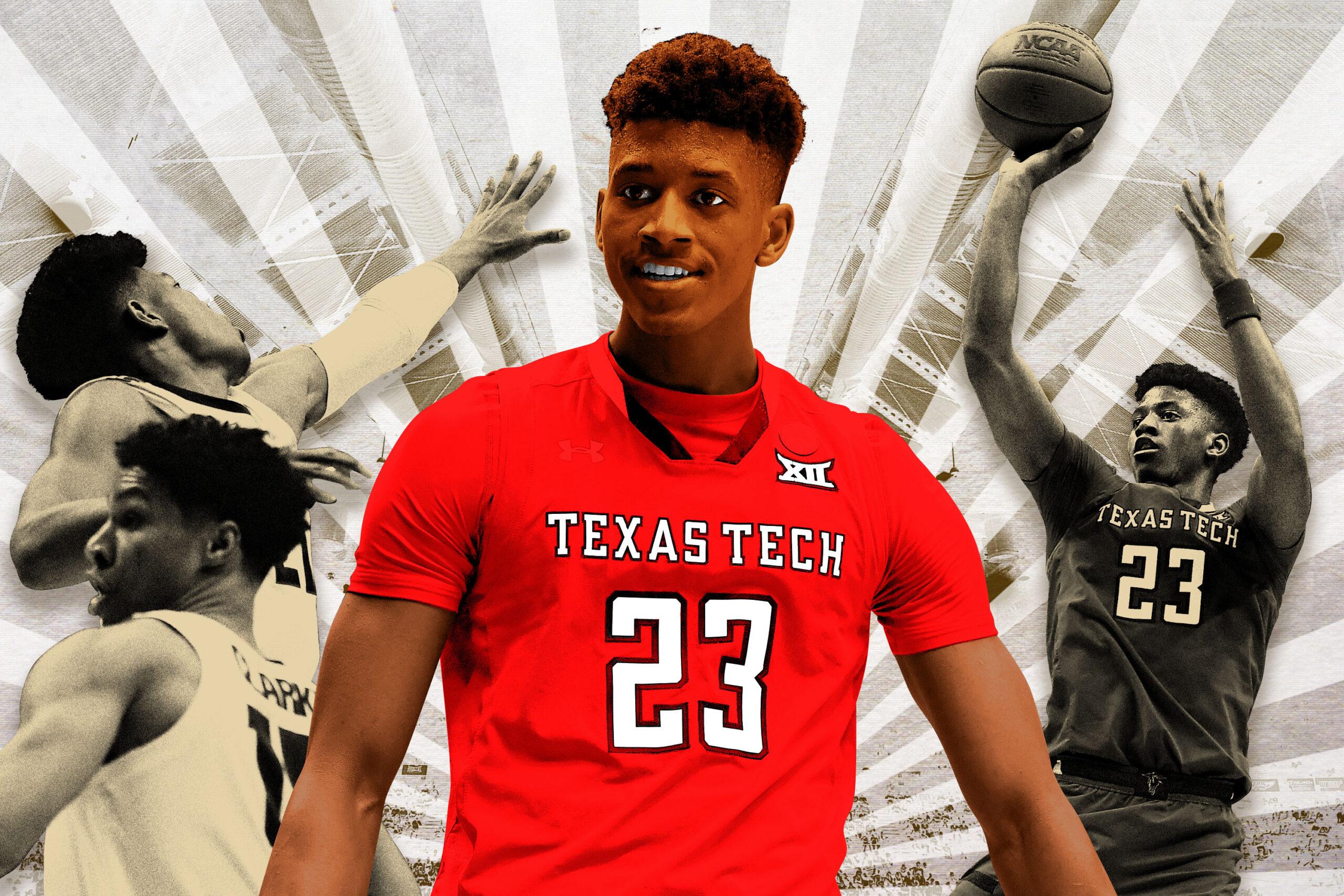Jarrett Culver Does Everything for Texas Tech. What Will Happen in the NBA When He Doesn’t Have To?
The Red Raiders star has led Texas Tech to unprecedented levels of success by being one of the most versatile players in college basketball. For NBA scouts, that’s both a gift and a curse.
Texas Tech has never had a player like Jarrett Culver. The sophomore guard is having a season of firsts. He’s the school’s first Big 12 Player of the Year, and he led Tech to its first Big 12 championship and first Final Four. Culver leads the team on a per-game basis in points (18.9), rebounds (6.4), assists (3.7), 3-point attempts (4.2), and free throw attempts (5.4), and he’s second in steals (1.5) and third in blocks (0.5). He started the season projected as a mid-to-late first-round pick and now may go in the top five. The concern for NBA teams is what he will do in a smaller role where everything doesn’t revolve around him. He doesn’t have one standout offensive skill. He will have to learn how to specialize at the next level.
Culver is one of the most versatile players in the country. Though listed at 6-foot-5 and 195 pounds, he plays much bigger than his size, which has led to speculation that he has grown in two seasons in college. Even if he’s not any taller than his official listings, he almost certainly has a much longer wingspan than most 6-foot-5 players, although we won’t know for sure until he gets measured at the NBA draft combine. Measurements will be important for Culver, because he isn’t a great athlete by NBA standards. He doesn’t have an elite first step and he doesn’t often play above the rim. He’s a smart player with a high basketball IQ who knows how to play to his strengths, and Red Raiders head coach Chris Beard has built an unorthodox scheme on both ends of the floor that maximizes the abilities of his best player.
Beard slides Culver around the lineup. He starts in a three-guard offense next to two ball handlers (senior Matt Mooney and sophomore Davide Moretti) and two traditional big men (seniors Tariq Owens and Norense Odiase). Culver also plays a lot of power forward over the course of the game, and his ability to guard bigger players gives Tech all the offensive benefits of playing four perimeter players without losing anything on defense. It’s important for his offense, too, because Culver isn’t a great outside shooter (31.6 percent from 3). He needs the extra space that smaller lineups create to attack the rim.
His offensive game is based on scoring inside and finding the open man when the defense collapses. Culver is a crafty player who stays in attack mode without forcing shots. His primary method of creating offense is as the ball handler in the pick-and-roll, where he gets 26.1 percent of his offensive possessions, according to the tracking numbers at Synergy Sports. Defenses tend to play off him, but he knows how to eat up space when he has a mismatch, either by using his size to score over smaller defenders or using his quickness to get around slower ones. Culver has great touch once he gets to his preferred spots on the floor: He shoots 68.4 percent around the rim, according to hoop-math.com, significantly higher than either RJ Barrett (64.4 percent) or Ja Morant (61.0 percent).
What makes Tech unique is the way it uses Culver when he doesn’t have the ball. Beard, a former assistant under Bob Knight, borrowed a lot of his motion offense concepts. The Red Raiders are no. 6 among teams from Power Five conferences in the percentage of their offense that comes from off-ball cuts. Culver is a perfect fit in that scheme. He knows exactly how to time cuts and use screens to get open in the paint. Beard has turned Culver into a deadly off-ball threat even though he’s only an average 3-point shooter. His ability to threaten the defense whether he’s playing on or off the ball makes life easier for his teammates. The Red Raiders don’t surround him with much high-level talent. No one else on their roster averages more than 12 points per game.
Tech wins games with the no. 1 rated defense in the country. It squeezed the life out of Michigan in a 62-44 victory in the Sweet 16 and held down Gonzaga, the no. 1 rated offense in the country, in a 75-69 win in the Elite Eight. Culver was at the center of everything. He’s an elite perimeter defender who also has the versatility to match up with 6-foot-8 Gonzaga junior Brandon Clarke, a potential lottery pick. He makes up for any lack of athleticism with long arms, a high motor, and a great understanding of positional defense. Culver always seems to be in the right place at the right time; he has one of the highest combinations of steal rate (2.7 percent) and block rate (2.1 percent) of any perimeter player in this year’s draft.
His defense will translate to the next level. The question is how effective his skill set will be in a more traditional NBA offense. There are some red flags from his performance in the NCAA tournament. He was dominant (29 points and seven assists on 10-of-17 shooting) in Tech’s first-round win over Northern Kentucky, a no. 14 seed, but he struggled to score efficiently (19.0 points on 36.4 percent shooting) against higher-level competition in its next three wins over Buffalo, Michigan, and Gonzaga. Culver is a streaky outside shooter who shot 22.9 percent from 3 on 4.4 attempts in 19 Big 12 games this season, and he’s shooting 6-of-22 from 3 (27.3 percent) in the tourney. He got to the rim when his shot wasn’t falling in the regular season. It wasn’t as easy for him against some of the elite defenders he faced last weekend.
Culver had trouble creating separation off the dribble against defenders who were bigger and more athletic than him. Michigan senior Charles Matthews (6-foot-6 and 205 pounds) is exactly the type of perimeter defender that Culver will face at the next level. He got into Culver’s chest and prevented him from getting to his spots in the first half of their Sweet 16 matchup. The adjustment that Tech made in the second half was putting Culver in more ball screens to get Matthews off him. That didn’t work against Gonzaga in the Elite Eight because the Bulldogs had two athletic 6-foot-8 combo forwards (Clarke and junior Rui Hachimura) who could switch screens and keep Culver in front of them on the perimeter. He had nowhere to go and wound up shooting 5-of-19 from the field.
It’s unclear what offensive role would make most sense for Culver in the NBA. He would be great as a secondary playmaker who can attack closeouts and take advantage of a rotating defense, but he would have to become a more consistent 3-point shooter. There is a lot of debate in NBA circles about how his outside shot will translate. The skeptics point to his poor career free throw shooting numbers (68.8 percent on 4.2 attempts per game). The optimists look at the improvements he made after tweaking his mechanics from his freshman season, going from the 11th percentile of players nationwide on off-the-dribble jumpers (on 33 attempts) to the 59th (on 133 attempts). Culver could keep improving once he gets to the next level, but there’s no guarantee that he will.
Playing him on the ball might not be the best answer, either. He doesn’t have the physical tools to create mismatches on the wing in the NBA. The only position where he would have a clear advantage in size or speed is point guard. Culver is a good decision-maker with enough feel for the game to handle the transition, but it would require a huge commitment from the team that drafts him. He would have to develop as both a ball handler and a passer to be successful in that role since he shares a lot of the playmaking responsibility in college with Moretti and Mooney. The idea would be to use him like Shai Gilgeous-Alexander, a 6-foot-6 point guard with great length and average athleticism who has had an impressive rookie campaign in the Clippers’ multiple-ball-handler offense.
Finding the right situation will be important for Culver at the next level. He could be an interesting fit in Chicago next to Zach LaVine, Otto Porter Jr., and Lauri Markkanen. While the Bulls would not have a traditional point guard, they would have enough shooting and passing around Culver to allow him to attack the rim without overloading him with playmaking responsibilities. And he would make Chicago better on defense than a smaller guard like Morant, since he could defend either backcourt position and allow the team to hide LaVine. Culver would have a harder time on a team like Cleveland, which already has a ball-dominant point guard (Collin Sexton) who would force him off the ball completely and make him a spot-up shooter.
Tech doesn’t have to worry about fit with Culver. Its concern is figuring out how everyone else fits around him. He could go down as the best player in school history. Not a lot of great players come through Lubbock, located nearly 300 miles from Dallas and 450 miles from Houston. Culver will be the first significant NBA player from the area since Craig Ehlo. Beard was blessed with a future NBA lottery pick who grew up in his backyard, and he built a Final Four team around him. Culver will not be the best player on his professional team, which means he will have to figure out how to complement someone else. He’s not a great outside shooter or passer at this stage in his career. He will have to pick one or the other in the NBA.

